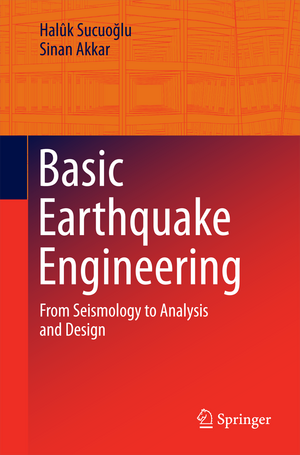Basic Earthquake Engineering: From Seismology to Analysis and Design
Autor Halûk Sucuoğlu, Sinan Akkaren Limba Engleză Paperback – 20 mai 2014
Preț: 584.43 lei
Preț vechi: 687.56 lei
-15% Nou
Puncte Express: 877
Preț estimativ în valută:
111.83€ • 119.59$ • 93.24£
111.83€ • 119.59$ • 93.24£
Carte tipărită la comandă
Livrare economică 18 aprilie-02 mai
Preluare comenzi: 021 569.72.76
Specificații
ISBN-13: 9783319010250
ISBN-10: 3319010255
Pagini: 300
Ilustrații: XIV, 288 p. 245 illus., 23 illus. in color.
Dimensiuni: 155 x 235 x 17 mm
Greutate: 0.43 kg
Ediția:2014
Editura: Springer International Publishing
Colecția Springer
Locul publicării:Cham, Switzerland
ISBN-10: 3319010255
Pagini: 300
Ilustrații: XIV, 288 p. 245 illus., 23 illus. in color.
Dimensiuni: 155 x 235 x 17 mm
Greutate: 0.43 kg
Ediția:2014
Editura: Springer International Publishing
Colecția Springer
Locul publicării:Cham, Switzerland
Public țintă
Upper undergraduateCuprins
Nature of Earthquakes.- Seismic Hazard Assessment.- Response of Simple Structures to Earthquake Ground Motions.- Earthquake Design Spectra.- Response of Building Frames to Earthquake Ground Motions.- Analysis Procedures and Seismic Design Principles for Building Structures.- Seismic Design of Reinforced Concrete Structures.
Notă biografică
Haluk Sucuoğlu is full professor of Civil Engineering at the Middle East Technical University, Ankara, Turkey, where he also manages the Building and Earthquake Engineering Laboratory. In addition, he is a member of teaching staff on the earthquake engineering program at Pavia University, Rose School, Italy. Professor Sucuoğlu is the current chairman of the Turkish Earthquake Engineering Association and he represents Turkey in the International Association of Earthquake Engineers (IAEE). He is a member of the editorial boards of numerous scientific journals.
Sinan Akkar is professor of Civil Engineering at the Middle East Technical University, Ankara, Turkey and also a member of teaching staff on the earthquake engineering program at Pavia University, Rose School, Italy. His main research interests are displacement-based seismic assessment and prediction of strong ground-motion parameters for seismic design. Professor Akkar is currently the Principal Investigator of the Turkish National Strong Motion Project and the NATO Project Director of the Harmonization of Seismic Hazard Maps for the Western Balkan Countries. He is involved in the Seismic Harmonization in Europe project (SHARE, EC-FP7) as a research member.
Sinan Akkar is professor of Civil Engineering at the Middle East Technical University, Ankara, Turkey and also a member of teaching staff on the earthquake engineering program at Pavia University, Rose School, Italy. His main research interests are displacement-based seismic assessment and prediction of strong ground-motion parameters for seismic design. Professor Akkar is currently the Principal Investigator of the Turkish National Strong Motion Project and the NATO Project Director of the Harmonization of Seismic Hazard Maps for the Western Balkan Countries. He is involved in the Seismic Harmonization in Europe project (SHARE, EC-FP7) as a research member.
Textul de pe ultima copertă
This book provides senior undergraduate students, master students and structural engineers who do not have a background in the field with core knowledge of structural earthquake engineering that will be invaluable in their professional lives. The basics of seismotectonics, including the causes, magnitude, and intensity of earthquakes, are first explained. Then the book introduces basic elements of seismic hazard analysis and presents the concept of a seismic hazard map for use in seismic design. Subsequent chapters cover key aspects of the response analysis of simple systems and building structures to earthquake ground motions, design spectrum, the adoption of seismic analysis procedures in seismic design codes, seismic design principles and seismic design of reinforced concrete structures. Helpful worked examples on seismic analysis of linear, nonlinear and base isolated buildings, earthquake-resistant design of frame and frame-shear wall systems are included, most of which can be solved using a hand calculator.
Caracteristici
Covers the seismic hazard, the basics of seismotectonics, and the fundamentals of earthquake engineering Meets the future professional needs of senior undergraduate students by explaining the principles of earthquake-resistant design Includes useful sample problems on earthquake-resistant design of frame and frame-shear wall systems Includes supplementary material: sn.pub/extras





